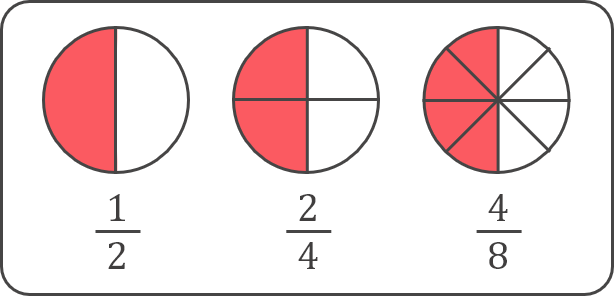How to Simplify Fractions to Their Lowest Terms
In the previous lesson, you learned how to find equivalent fractions.
Equivalent fractions are fractions that have the same value even though they have different numerators and denominators, like 1/2, 2/4, and 4/8.
1/2 is simpler than 2/4 and 4/8.
A fraction is in its simplest, or lowest, terms if we can't do anything to make the numerator and the denominator smaller.
1/2 is the simplest term for 2/4. It's also the simplest term for 4/8. ✅
How do we simplify a fraction to its lowest term? 🤔
Simplifying Fractions Using Repeated Division
One way to simplify a fraction is by repeated division.
We divide the numerator and the denominator over and over until we can't go any further.
Let's try it with an example.
Write the fraction 36/54 in its simplest form.
36 and 54 are both even numbers.
So we can divide both 36 and 54 by 2.
Can we divide 18 and 27 further? 🤔
That's right. 👍 We can divide both 18 and 27 by 3.
Is there a number that we can use to divide both 6 and 9? 🤔
Yes! We can divide them by 3 again.
Can we divide 2 and 3 any further?
Not anymore. That means we've found the simplest form!
The simplest form of 36/54 is 2/3. ✅
Tip: equivalent fractions always simplify down to the same number.
Great job.
Simplifying Fractions Using the Greatest Common Factor
Another way to simplify a fraction is by using the greatest common factor to divide the numbers.
Factors are the numbers that we multiply to get a product.
The greatest common factor of two numbers is the biggest number that is a factor of both numbers.
What's the greatest common factor of the numerator and denominator of 36/54? 🤔
First, we list the factors of 36.
1, 2, 3, 4, 6, 9, 12, 18, 36
Next, we list the factors of 54.
1, 2, 3, 6, 9, 18, 27, 54
Now, we find the common factors, that both numbers have.
1, 2, 3, 6, 9, 18
The greatest factor common is 18. It's the largest number in the list of common factors.
Let's simply our fraction using the greatest common factor! 😀
We divide both the numerator and the denominator by 18.
This shows us that the simplest form of 36/54 is 2/3. ✅
So, we just learned that dividing by the greatest common factor of the numerator and denominator gets us right to the simplest form in one jump.
It's the same answer as the one we got using repeated division.
Good job. 👏
You just learned how to simplify fractions to their lowest terms. 🎉
Next, let's ace the practice.
1,000 Create Credits is worth $1 in real AI compute time.
1 Create Credit is enough to get 1 question answered, or to generate 1 image from text, in the tools tab.










